Analyzing the Effects of Communication on Workflow in Organizations
VerifiedAdded on 2022/08/10
|6
|2294
|311
Report
AI Summary
This report examines the critical impact of communication on organizational workflow, analyzing different forms such as verbal, written, visual, and non-verbal communication. It explores various types of communication flow, including downward, upward, lateral, diagonal, and external, highlighting their roles and effects on employee performance and overall firm productivity. The report also evaluates strategies for improving business communication, such as providing employee training, encouraging active listening, and promoting the use of advanced technologies. It concludes that effective communication enhances workflow quality and recommends training programs to improve communication skills, along with self-development processes to eliminate misunderstandings and improve business bonds. The report emphasizes the importance of clear, respectful, and technology-driven communication to achieve organizational success and maintain a competitive advantage.
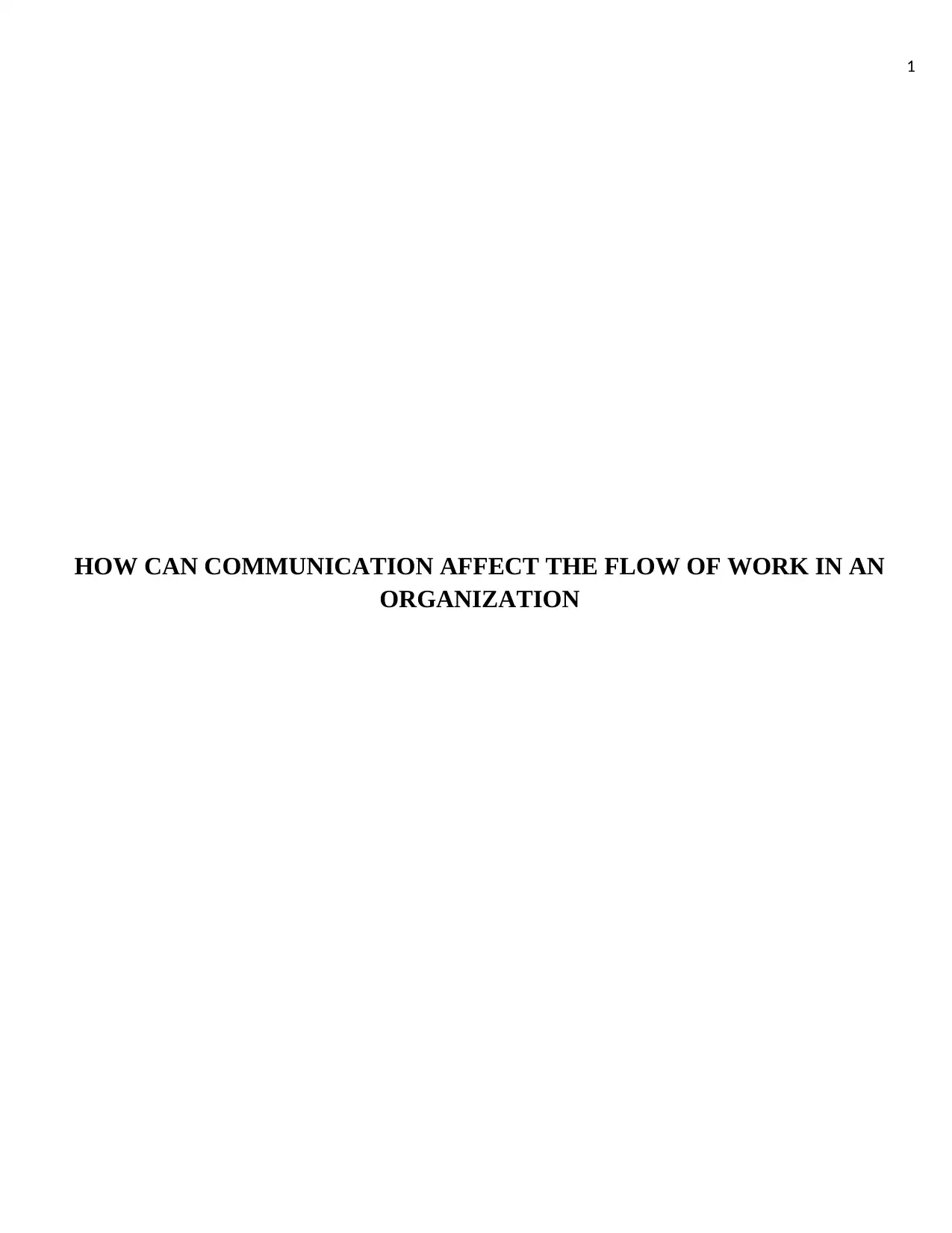
1
HOW CAN COMMUNICATION AFFECT THE FLOW OF WORK IN AN
ORGANIZATION
HOW CAN COMMUNICATION AFFECT THE FLOW OF WORK IN AN
ORGANIZATION
Paraphrase This Document
Need a fresh take? Get an instant paraphrase of this document with our AI Paraphraser
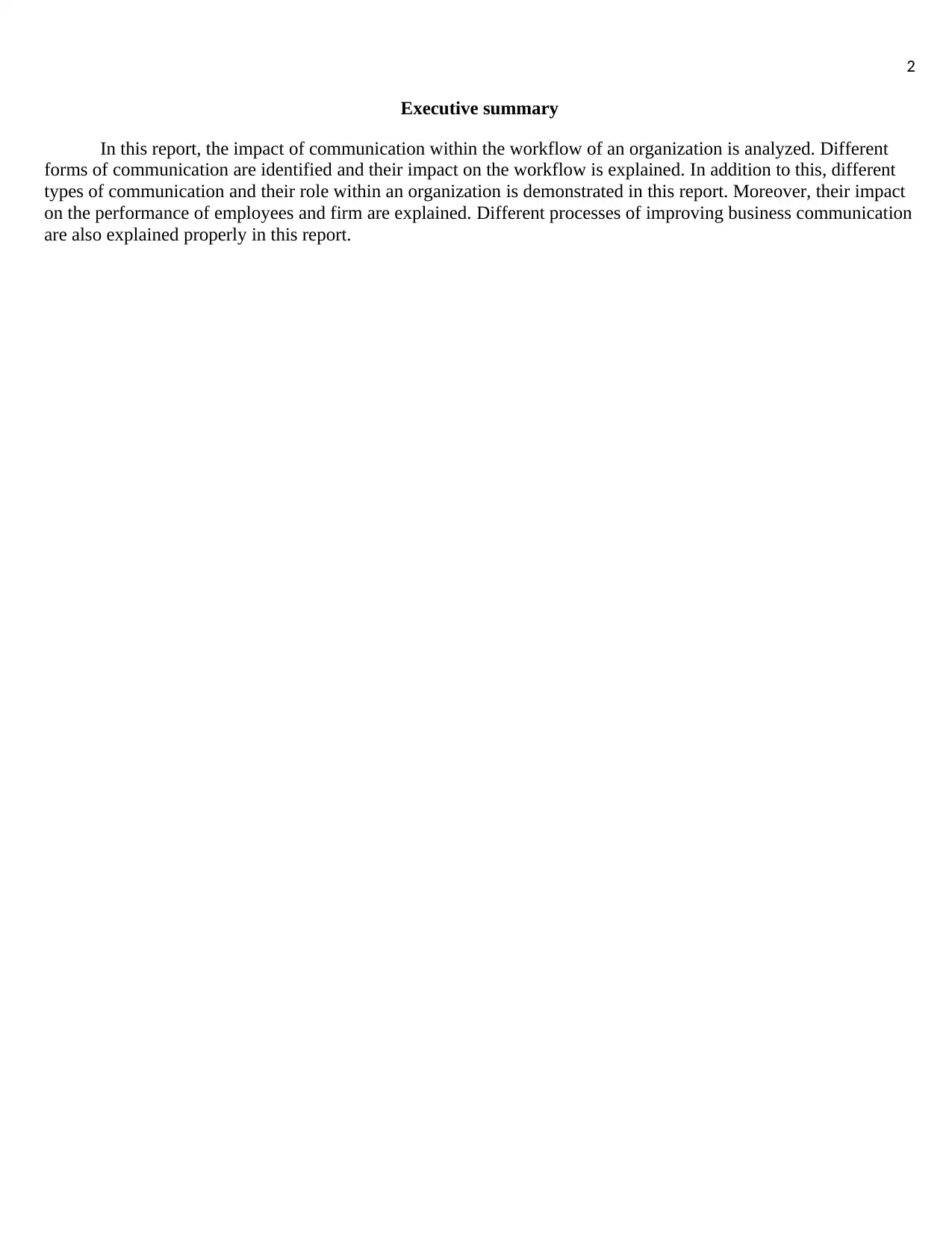
2
Executive summary
In this report, the impact of communication within the workflow of an organization is analyzed. Different
forms of communication are identified and their impact on the workflow is explained. In addition to this, different
types of communication and their role within an organization is demonstrated in this report. Moreover, their impact
on the performance of employees and firm are explained. Different processes of improving business communication
are also explained properly in this report.
Executive summary
In this report, the impact of communication within the workflow of an organization is analyzed. Different
forms of communication are identified and their impact on the workflow is explained. In addition to this, different
types of communication and their role within an organization is demonstrated in this report. Moreover, their impact
on the performance of employees and firm are explained. Different processes of improving business communication
are also explained properly in this report.
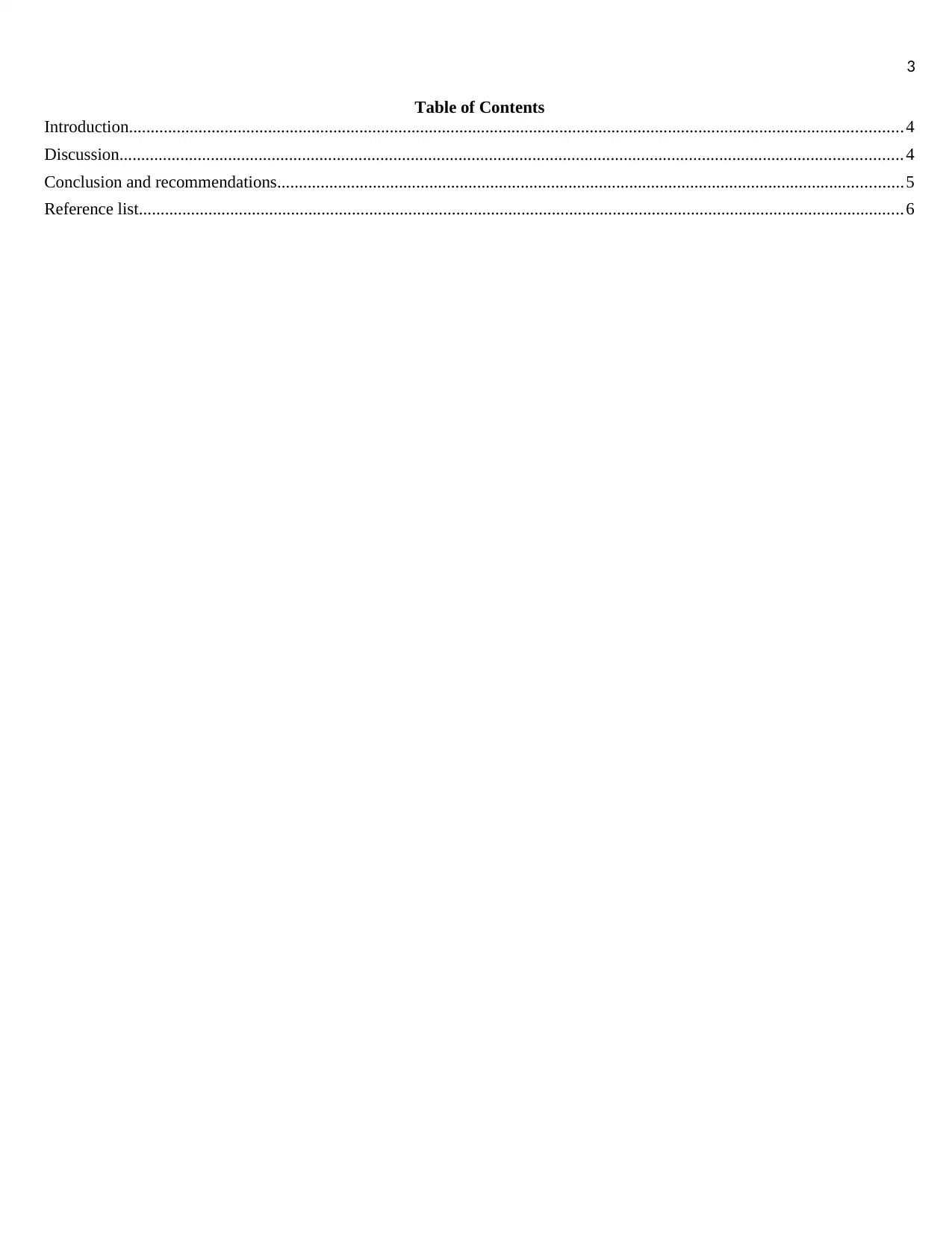
3
Table of Contents
Introduction.................................................................................................................................................................................. 4
Discussion.................................................................................................................................................................................... 4
Conclusion and recommendations................................................................................................................................................5
Reference list................................................................................................................................................................................6
Table of Contents
Introduction.................................................................................................................................................................................. 4
Discussion.................................................................................................................................................................................... 4
Conclusion and recommendations................................................................................................................................................5
Reference list................................................................................................................................................................................6
⊘ This is a preview!⊘
Do you want full access?
Subscribe today to unlock all pages.

Trusted by 1+ million students worldwide
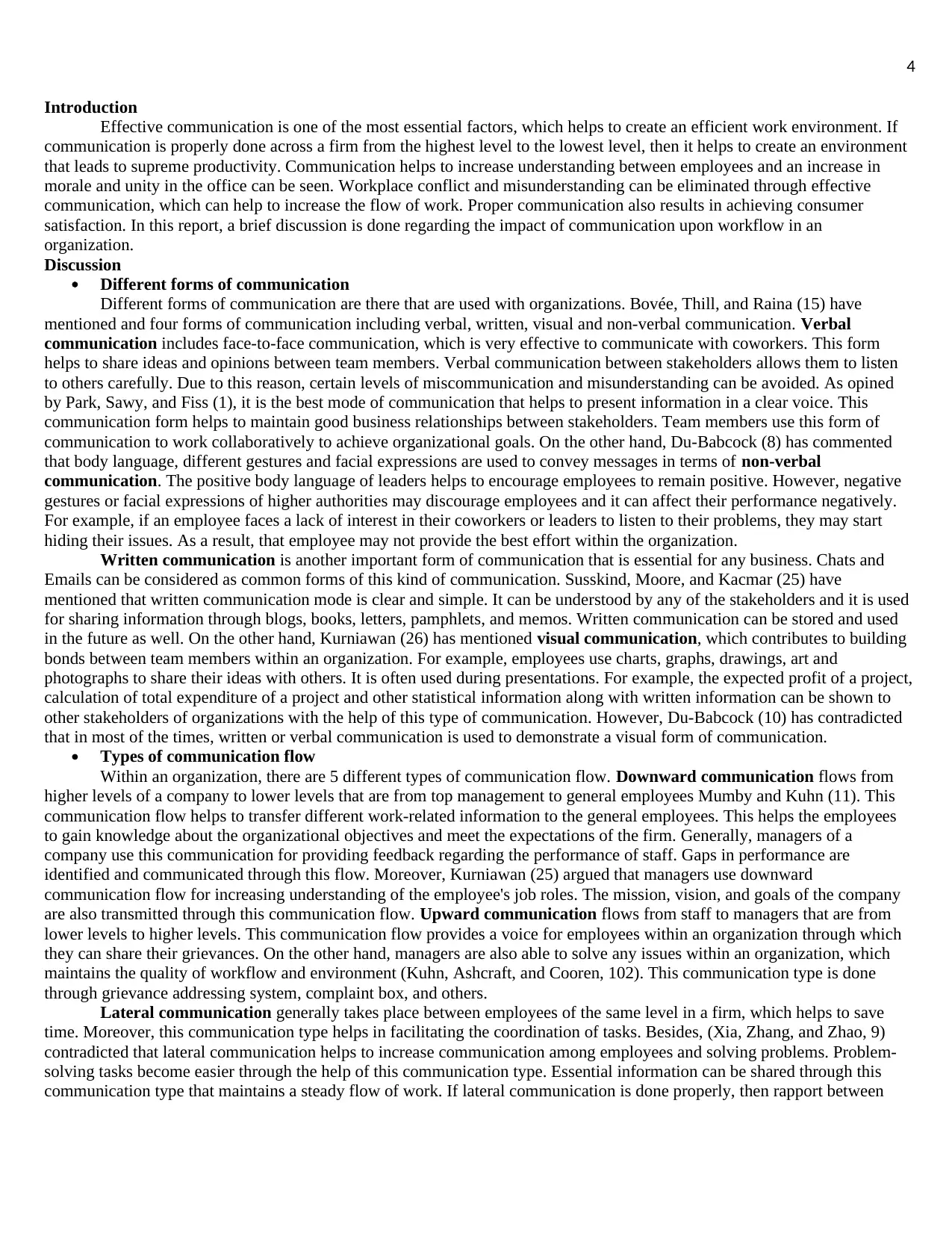
4
Introduction
Effective communication is one of the most essential factors, which helps to create an efficient work environment. If
communication is properly done across a firm from the highest level to the lowest level, then it helps to create an environment
that leads to supreme productivity. Communication helps to increase understanding between employees and an increase in
morale and unity in the office can be seen. Workplace conflict and misunderstanding can be eliminated through effective
communication, which can help to increase the flow of work. Proper communication also results in achieving consumer
satisfaction. In this report, a brief discussion is done regarding the impact of communication upon workflow in an
organization.
Discussion
Different forms of communication
Different forms of communication are there that are used with organizations. Bovée, Thill, and Raina (15) have
mentioned and four forms of communication including verbal, written, visual and non-verbal communication. Verbal
communication includes face-to-face communication, which is very effective to communicate with coworkers. This form
helps to share ideas and opinions between team members. Verbal communication between stakeholders allows them to listen
to others carefully. Due to this reason, certain levels of miscommunication and misunderstanding can be avoided. As opined
by Park, Sawy, and Fiss (1), it is the best mode of communication that helps to present information in a clear voice. This
communication form helps to maintain good business relationships between stakeholders. Team members use this form of
communication to work collaboratively to achieve organizational goals. On the other hand, Du-Babcock (8) has commented
that body language, different gestures and facial expressions are used to convey messages in terms of non-verbal
communication. The positive body language of leaders helps to encourage employees to remain positive. However, negative
gestures or facial expressions of higher authorities may discourage employees and it can affect their performance negatively.
For example, if an employee faces a lack of interest in their coworkers or leaders to listen to their problems, they may start
hiding their issues. As a result, that employee may not provide the best effort within the organization.
Written communication is another important form of communication that is essential for any business. Chats and
Emails can be considered as common forms of this kind of communication. Susskind, Moore, and Kacmar (25) have
mentioned that written communication mode is clear and simple. It can be understood by any of the stakeholders and it is used
for sharing information through blogs, books, letters, pamphlets, and memos. Written communication can be stored and used
in the future as well. On the other hand, Kurniawan (26) has mentioned visual communication, which contributes to building
bonds between team members within an organization. For example, employees use charts, graphs, drawings, art and
photographs to share their ideas with others. It is often used during presentations. For example, the expected profit of a project,
calculation of total expenditure of a project and other statistical information along with written information can be shown to
other stakeholders of organizations with the help of this type of communication. However, Du-Babcock (10) has contradicted
that in most of the times, written or verbal communication is used to demonstrate a visual form of communication.
Types of communication flow
Within an organization, there are 5 different types of communication flow. Downward communication flows from
higher levels of a company to lower levels that are from top management to general employees Mumby and Kuhn (11). This
communication flow helps to transfer different work-related information to the general employees. This helps the employees
to gain knowledge about the organizational objectives and meet the expectations of the firm. Generally, managers of a
company use this communication for providing feedback regarding the performance of staff. Gaps in performance are
identified and communicated through this flow. Moreover, Kurniawan (25) argued that managers use downward
communication flow for increasing understanding of the employee's job roles. The mission, vision, and goals of the company
are also transmitted through this communication flow. Upward communication flows from staff to managers that are from
lower levels to higher levels. This communication flow provides a voice for employees within an organization through which
they can share their grievances. On the other hand, managers are also able to solve any issues within an organization, which
maintains the quality of workflow and environment (Kuhn, Ashcraft, and Cooren, 102). This communication type is done
through grievance addressing system, complaint box, and others.
Lateral communication generally takes place between employees of the same level in a firm, which helps to save
time. Moreover, this communication type helps in facilitating the coordination of tasks. Besides, (Xia, Zhang, and Zhao, 9)
contradicted that lateral communication helps to increase communication among employees and solving problems. Problem-
solving tasks become easier through the help of this communication type. Essential information can be shared through this
communication type that maintains a steady flow of work. If lateral communication is done properly, then rapport between
Introduction
Effective communication is one of the most essential factors, which helps to create an efficient work environment. If
communication is properly done across a firm from the highest level to the lowest level, then it helps to create an environment
that leads to supreme productivity. Communication helps to increase understanding between employees and an increase in
morale and unity in the office can be seen. Workplace conflict and misunderstanding can be eliminated through effective
communication, which can help to increase the flow of work. Proper communication also results in achieving consumer
satisfaction. In this report, a brief discussion is done regarding the impact of communication upon workflow in an
organization.
Discussion
Different forms of communication
Different forms of communication are there that are used with organizations. Bovée, Thill, and Raina (15) have
mentioned and four forms of communication including verbal, written, visual and non-verbal communication. Verbal
communication includes face-to-face communication, which is very effective to communicate with coworkers. This form
helps to share ideas and opinions between team members. Verbal communication between stakeholders allows them to listen
to others carefully. Due to this reason, certain levels of miscommunication and misunderstanding can be avoided. As opined
by Park, Sawy, and Fiss (1), it is the best mode of communication that helps to present information in a clear voice. This
communication form helps to maintain good business relationships between stakeholders. Team members use this form of
communication to work collaboratively to achieve organizational goals. On the other hand, Du-Babcock (8) has commented
that body language, different gestures and facial expressions are used to convey messages in terms of non-verbal
communication. The positive body language of leaders helps to encourage employees to remain positive. However, negative
gestures or facial expressions of higher authorities may discourage employees and it can affect their performance negatively.
For example, if an employee faces a lack of interest in their coworkers or leaders to listen to their problems, they may start
hiding their issues. As a result, that employee may not provide the best effort within the organization.
Written communication is another important form of communication that is essential for any business. Chats and
Emails can be considered as common forms of this kind of communication. Susskind, Moore, and Kacmar (25) have
mentioned that written communication mode is clear and simple. It can be understood by any of the stakeholders and it is used
for sharing information through blogs, books, letters, pamphlets, and memos. Written communication can be stored and used
in the future as well. On the other hand, Kurniawan (26) has mentioned visual communication, which contributes to building
bonds between team members within an organization. For example, employees use charts, graphs, drawings, art and
photographs to share their ideas with others. It is often used during presentations. For example, the expected profit of a project,
calculation of total expenditure of a project and other statistical information along with written information can be shown to
other stakeholders of organizations with the help of this type of communication. However, Du-Babcock (10) has contradicted
that in most of the times, written or verbal communication is used to demonstrate a visual form of communication.
Types of communication flow
Within an organization, there are 5 different types of communication flow. Downward communication flows from
higher levels of a company to lower levels that are from top management to general employees Mumby and Kuhn (11). This
communication flow helps to transfer different work-related information to the general employees. This helps the employees
to gain knowledge about the organizational objectives and meet the expectations of the firm. Generally, managers of a
company use this communication for providing feedback regarding the performance of staff. Gaps in performance are
identified and communicated through this flow. Moreover, Kurniawan (25) argued that managers use downward
communication flow for increasing understanding of the employee's job roles. The mission, vision, and goals of the company
are also transmitted through this communication flow. Upward communication flows from staff to managers that are from
lower levels to higher levels. This communication flow provides a voice for employees within an organization through which
they can share their grievances. On the other hand, managers are also able to solve any issues within an organization, which
maintains the quality of workflow and environment (Kuhn, Ashcraft, and Cooren, 102). This communication type is done
through grievance addressing system, complaint box, and others.
Lateral communication generally takes place between employees of the same level in a firm, which helps to save
time. Moreover, this communication type helps in facilitating the coordination of tasks. Besides, (Xia, Zhang, and Zhao, 9)
contradicted that lateral communication helps to increase communication among employees and solving problems. Problem-
solving tasks become easier through the help of this communication type. Essential information can be shared through this
communication type that maintains a steady flow of work. If lateral communication is done properly, then rapport between
Paraphrase This Document
Need a fresh take? Get an instant paraphrase of this document with our AI Paraphraser
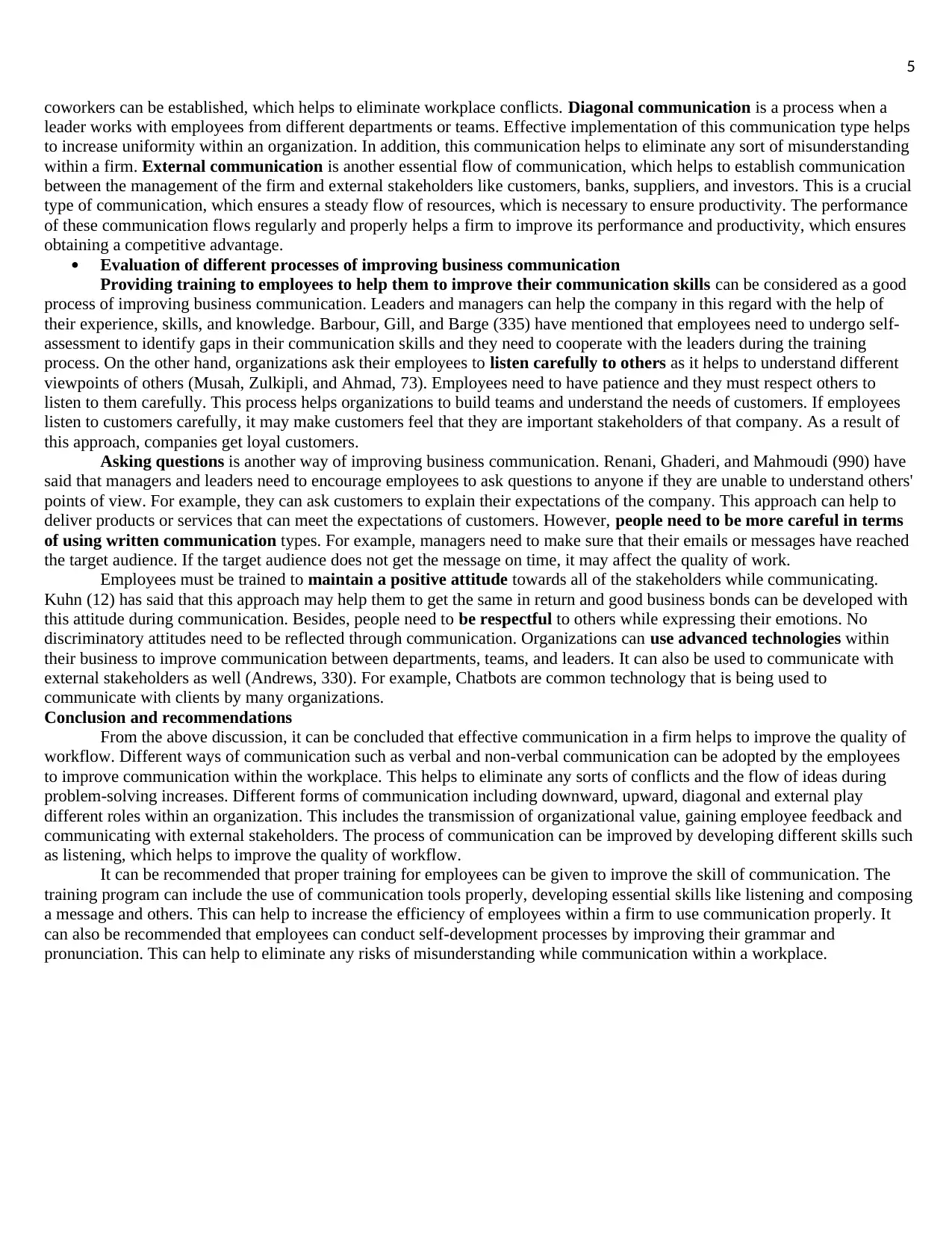
5
coworkers can be established, which helps to eliminate workplace conflicts. Diagonal communication is a process when a
leader works with employees from different departments or teams. Effective implementation of this communication type helps
to increase uniformity within an organization. In addition, this communication helps to eliminate any sort of misunderstanding
within a firm. External communication is another essential flow of communication, which helps to establish communication
between the management of the firm and external stakeholders like customers, banks, suppliers, and investors. This is a crucial
type of communication, which ensures a steady flow of resources, which is necessary to ensure productivity. The performance
of these communication flows regularly and properly helps a firm to improve its performance and productivity, which ensures
obtaining a competitive advantage.
Evaluation of different processes of improving business communication
Providing training to employees to help them to improve their communication skills can be considered as a good
process of improving business communication. Leaders and managers can help the company in this regard with the help of
their experience, skills, and knowledge. Barbour, Gill, and Barge (335) have mentioned that employees need to undergo self-
assessment to identify gaps in their communication skills and they need to cooperate with the leaders during the training
process. On the other hand, organizations ask their employees to listen carefully to others as it helps to understand different
viewpoints of others (Musah, Zulkipli, and Ahmad, 73). Employees need to have patience and they must respect others to
listen to them carefully. This process helps organizations to build teams and understand the needs of customers. If employees
listen to customers carefully, it may make customers feel that they are important stakeholders of that company. As a result of
this approach, companies get loyal customers.
Asking questions is another way of improving business communication. Renani, Ghaderi, and Mahmoudi (990) have
said that managers and leaders need to encourage employees to ask questions to anyone if they are unable to understand others'
points of view. For example, they can ask customers to explain their expectations of the company. This approach can help to
deliver products or services that can meet the expectations of customers. However, people need to be more careful in terms
of using written communication types. For example, managers need to make sure that their emails or messages have reached
the target audience. If the target audience does not get the message on time, it may affect the quality of work.
Employees must be trained to maintain a positive attitude towards all of the stakeholders while communicating.
Kuhn (12) has said that this approach may help them to get the same in return and good business bonds can be developed with
this attitude during communication. Besides, people need to be respectful to others while expressing their emotions. No
discriminatory attitudes need to be reflected through communication. Organizations can use advanced technologies within
their business to improve communication between departments, teams, and leaders. It can also be used to communicate with
external stakeholders as well (Andrews, 330). For example, Chatbots are common technology that is being used to
communicate with clients by many organizations.
Conclusion and recommendations
From the above discussion, it can be concluded that effective communication in a firm helps to improve the quality of
workflow. Different ways of communication such as verbal and non-verbal communication can be adopted by the employees
to improve communication within the workplace. This helps to eliminate any sorts of conflicts and the flow of ideas during
problem-solving increases. Different forms of communication including downward, upward, diagonal and external play
different roles within an organization. This includes the transmission of organizational value, gaining employee feedback and
communicating with external stakeholders. The process of communication can be improved by developing different skills such
as listening, which helps to improve the quality of workflow.
It can be recommended that proper training for employees can be given to improve the skill of communication. The
training program can include the use of communication tools properly, developing essential skills like listening and composing
a message and others. This can help to increase the efficiency of employees within a firm to use communication properly. It
can also be recommended that employees can conduct self-development processes by improving their grammar and
pronunciation. This can help to eliminate any risks of misunderstanding while communication within a workplace.
coworkers can be established, which helps to eliminate workplace conflicts. Diagonal communication is a process when a
leader works with employees from different departments or teams. Effective implementation of this communication type helps
to increase uniformity within an organization. In addition, this communication helps to eliminate any sort of misunderstanding
within a firm. External communication is another essential flow of communication, which helps to establish communication
between the management of the firm and external stakeholders like customers, banks, suppliers, and investors. This is a crucial
type of communication, which ensures a steady flow of resources, which is necessary to ensure productivity. The performance
of these communication flows regularly and properly helps a firm to improve its performance and productivity, which ensures
obtaining a competitive advantage.
Evaluation of different processes of improving business communication
Providing training to employees to help them to improve their communication skills can be considered as a good
process of improving business communication. Leaders and managers can help the company in this regard with the help of
their experience, skills, and knowledge. Barbour, Gill, and Barge (335) have mentioned that employees need to undergo self-
assessment to identify gaps in their communication skills and they need to cooperate with the leaders during the training
process. On the other hand, organizations ask their employees to listen carefully to others as it helps to understand different
viewpoints of others (Musah, Zulkipli, and Ahmad, 73). Employees need to have patience and they must respect others to
listen to them carefully. This process helps organizations to build teams and understand the needs of customers. If employees
listen to customers carefully, it may make customers feel that they are important stakeholders of that company. As a result of
this approach, companies get loyal customers.
Asking questions is another way of improving business communication. Renani, Ghaderi, and Mahmoudi (990) have
said that managers and leaders need to encourage employees to ask questions to anyone if they are unable to understand others'
points of view. For example, they can ask customers to explain their expectations of the company. This approach can help to
deliver products or services that can meet the expectations of customers. However, people need to be more careful in terms
of using written communication types. For example, managers need to make sure that their emails or messages have reached
the target audience. If the target audience does not get the message on time, it may affect the quality of work.
Employees must be trained to maintain a positive attitude towards all of the stakeholders while communicating.
Kuhn (12) has said that this approach may help them to get the same in return and good business bonds can be developed with
this attitude during communication. Besides, people need to be respectful to others while expressing their emotions. No
discriminatory attitudes need to be reflected through communication. Organizations can use advanced technologies within
their business to improve communication between departments, teams, and leaders. It can also be used to communicate with
external stakeholders as well (Andrews, 330). For example, Chatbots are common technology that is being used to
communicate with clients by many organizations.
Conclusion and recommendations
From the above discussion, it can be concluded that effective communication in a firm helps to improve the quality of
workflow. Different ways of communication such as verbal and non-verbal communication can be adopted by the employees
to improve communication within the workplace. This helps to eliminate any sorts of conflicts and the flow of ideas during
problem-solving increases. Different forms of communication including downward, upward, diagonal and external play
different roles within an organization. This includes the transmission of organizational value, gaining employee feedback and
communicating with external stakeholders. The process of communication can be improved by developing different skills such
as listening, which helps to improve the quality of workflow.
It can be recommended that proper training for employees can be given to improve the skill of communication. The
training program can include the use of communication tools properly, developing essential skills like listening and composing
a message and others. This can help to increase the efficiency of employees within a firm to use communication properly. It
can also be recommended that employees can conduct self-development processes by improving their grammar and
pronunciation. This can help to eliminate any risks of misunderstanding while communication within a workplace.
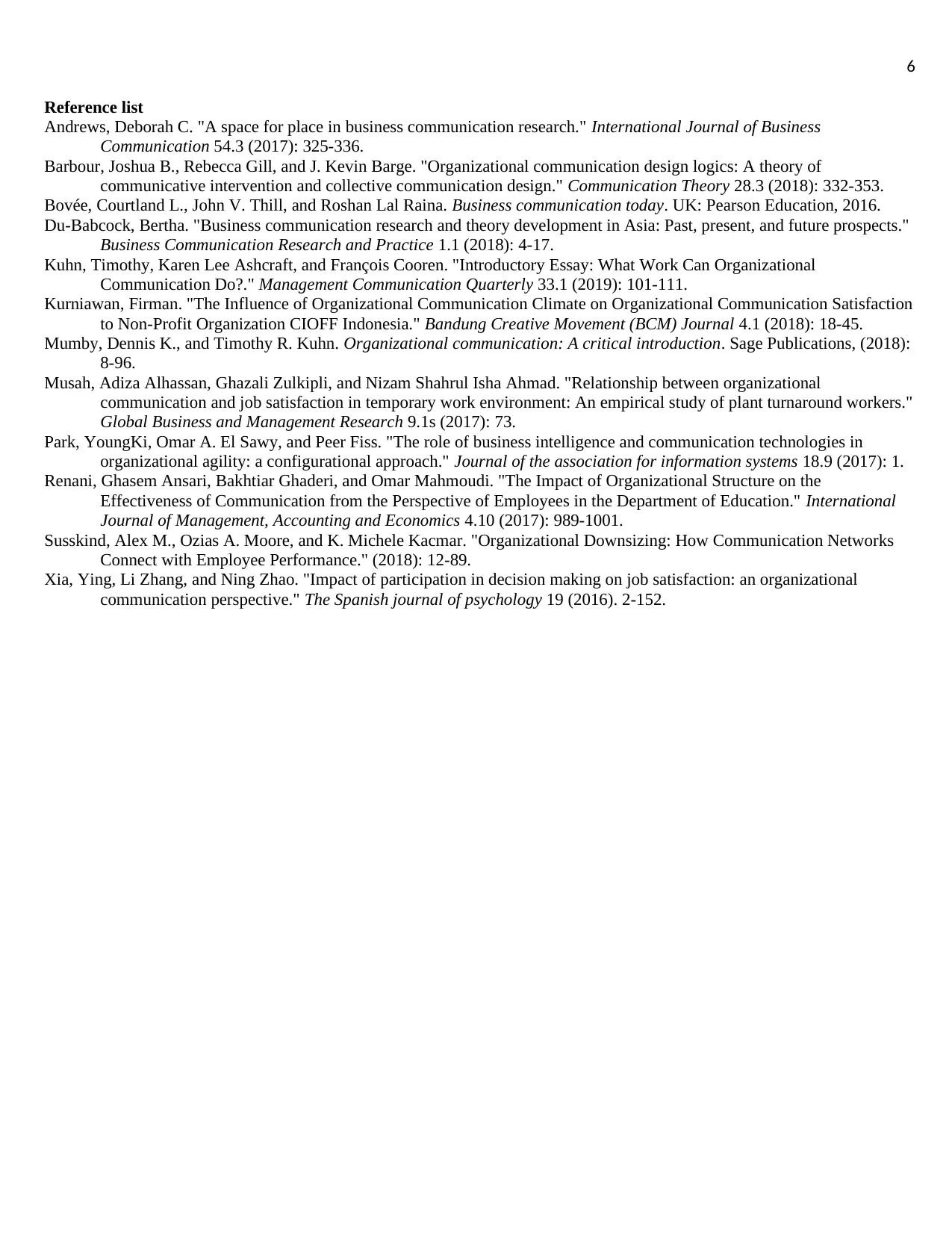
6
Reference list
Andrews, Deborah C. "A space for place in business communication research." International Journal of Business
Communication 54.3 (2017): 325-336.
Barbour, Joshua B., Rebecca Gill, and J. Kevin Barge. "Organizational communication design logics: A theory of
communicative intervention and collective communication design." Communication Theory 28.3 (2018): 332-353.
Bovée, Courtland L., John V. Thill, and Roshan Lal Raina. Business communication today. UK: Pearson Education, 2016.
Du-Babcock, Bertha. "Business communication research and theory development in Asia: Past, present, and future prospects."
Business Communication Research and Practice 1.1 (2018): 4-17.
Kuhn, Timothy, Karen Lee Ashcraft, and François Cooren. "Introductory Essay: What Work Can Organizational
Communication Do?." Management Communication Quarterly 33.1 (2019): 101-111.
Kurniawan, Firman. "The Influence of Organizational Communication Climate on Organizational Communication Satisfaction
to Non-Profit Organization CIOFF Indonesia." Bandung Creative Movement (BCM) Journal 4.1 (2018): 18-45.
Mumby, Dennis K., and Timothy R. Kuhn. Organizational communication: A critical introduction. Sage Publications, (2018):
8-96.
Musah, Adiza Alhassan, Ghazali Zulkipli, and Nizam Shahrul Isha Ahmad. "Relationship between organizational
communication and job satisfaction in temporary work environment: An empirical study of plant turnaround workers."
Global Business and Management Research 9.1s (2017): 73.
Park, YoungKi, Omar A. El Sawy, and Peer Fiss. "The role of business intelligence and communication technologies in
organizational agility: a configurational approach." Journal of the association for information systems 18.9 (2017): 1.
Renani, Ghasem Ansari, Bakhtiar Ghaderi, and Omar Mahmoudi. "The Impact of Organizational Structure on the
Effectiveness of Communication from the Perspective of Employees in the Department of Education." International
Journal of Management, Accounting and Economics 4.10 (2017): 989-1001.
Susskind, Alex M., Ozias A. Moore, and K. Michele Kacmar. "Organizational Downsizing: How Communication Networks
Connect with Employee Performance." (2018): 12-89.
Xia, Ying, Li Zhang, and Ning Zhao. "Impact of participation in decision making on job satisfaction: an organizational
communication perspective." The Spanish journal of psychology 19 (2016). 2-152.
Reference list
Andrews, Deborah C. "A space for place in business communication research." International Journal of Business
Communication 54.3 (2017): 325-336.
Barbour, Joshua B., Rebecca Gill, and J. Kevin Barge. "Organizational communication design logics: A theory of
communicative intervention and collective communication design." Communication Theory 28.3 (2018): 332-353.
Bovée, Courtland L., John V. Thill, and Roshan Lal Raina. Business communication today. UK: Pearson Education, 2016.
Du-Babcock, Bertha. "Business communication research and theory development in Asia: Past, present, and future prospects."
Business Communication Research and Practice 1.1 (2018): 4-17.
Kuhn, Timothy, Karen Lee Ashcraft, and François Cooren. "Introductory Essay: What Work Can Organizational
Communication Do?." Management Communication Quarterly 33.1 (2019): 101-111.
Kurniawan, Firman. "The Influence of Organizational Communication Climate on Organizational Communication Satisfaction
to Non-Profit Organization CIOFF Indonesia." Bandung Creative Movement (BCM) Journal 4.1 (2018): 18-45.
Mumby, Dennis K., and Timothy R. Kuhn. Organizational communication: A critical introduction. Sage Publications, (2018):
8-96.
Musah, Adiza Alhassan, Ghazali Zulkipli, and Nizam Shahrul Isha Ahmad. "Relationship between organizational
communication and job satisfaction in temporary work environment: An empirical study of plant turnaround workers."
Global Business and Management Research 9.1s (2017): 73.
Park, YoungKi, Omar A. El Sawy, and Peer Fiss. "The role of business intelligence and communication technologies in
organizational agility: a configurational approach." Journal of the association for information systems 18.9 (2017): 1.
Renani, Ghasem Ansari, Bakhtiar Ghaderi, and Omar Mahmoudi. "The Impact of Organizational Structure on the
Effectiveness of Communication from the Perspective of Employees in the Department of Education." International
Journal of Management, Accounting and Economics 4.10 (2017): 989-1001.
Susskind, Alex M., Ozias A. Moore, and K. Michele Kacmar. "Organizational Downsizing: How Communication Networks
Connect with Employee Performance." (2018): 12-89.
Xia, Ying, Li Zhang, and Ning Zhao. "Impact of participation in decision making on job satisfaction: an organizational
communication perspective." The Spanish journal of psychology 19 (2016). 2-152.
⊘ This is a preview!⊘
Do you want full access?
Subscribe today to unlock all pages.

Trusted by 1+ million students worldwide
1 out of 6
Related Documents
Your All-in-One AI-Powered Toolkit for Academic Success.
+13062052269
info@desklib.com
Available 24*7 on WhatsApp / Email
![[object Object]](/_next/static/media/star-bottom.7253800d.svg)
Unlock your academic potential
Copyright © 2020–2025 A2Z Services. All Rights Reserved. Developed and managed by ZUCOL.




